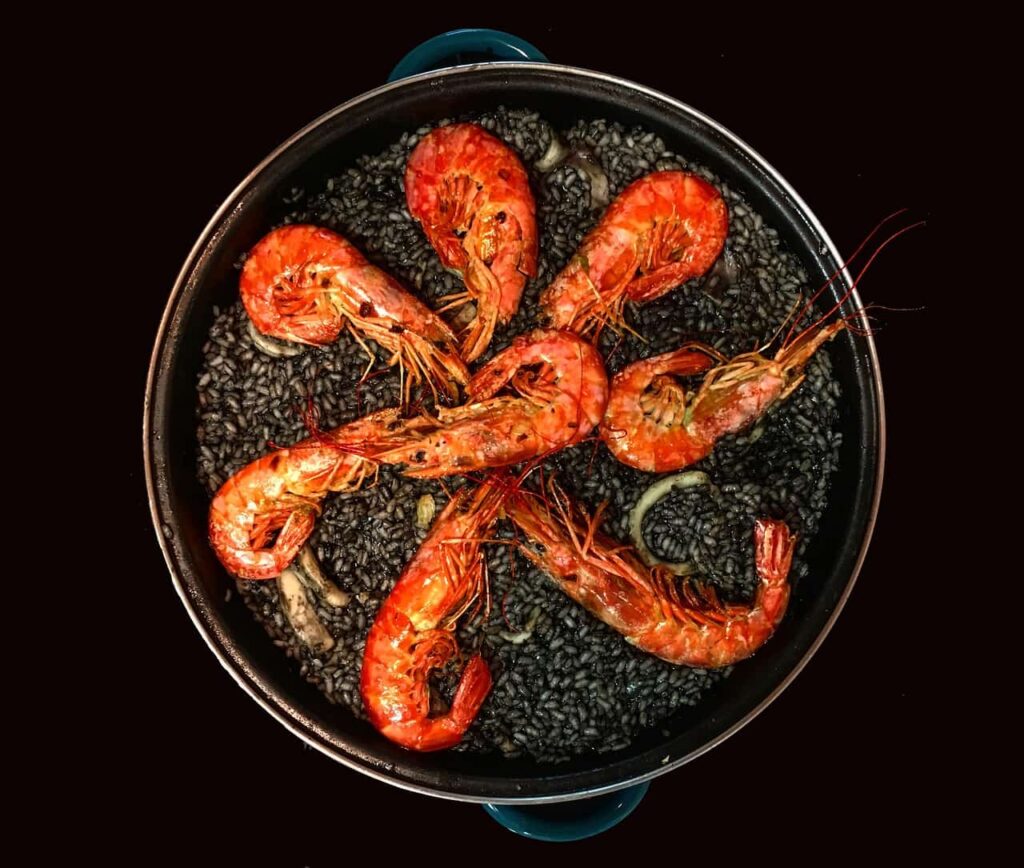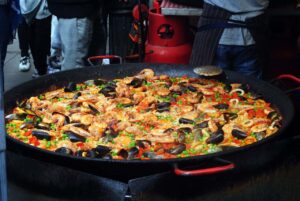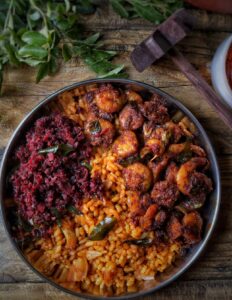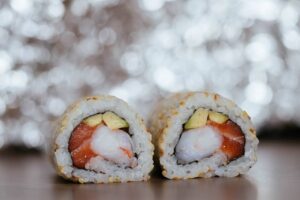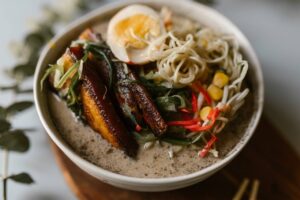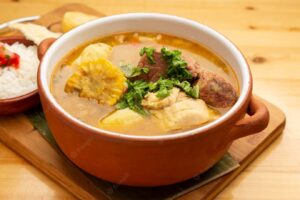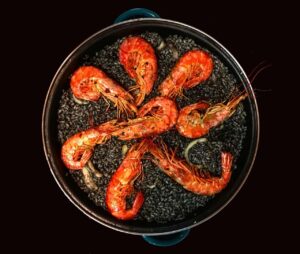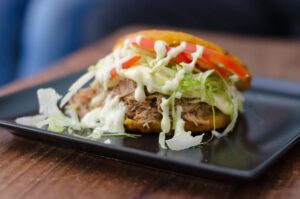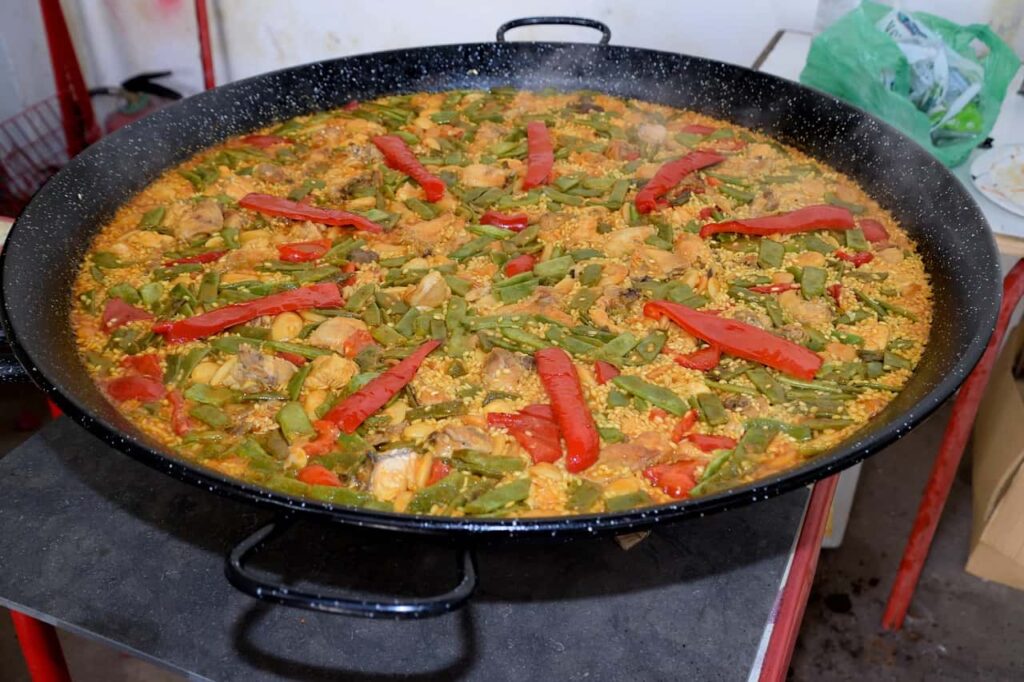
Paella (/paɪˈɛlə/pɑːˈeɪjə/, py-EL-ə, pah-AY-yə, Valencian: [paˈeʎa], Spanish: [paˈeʝa]) is a rice dish originally from Valencia. While it is commonly viewed by non-Spaniards as Spain’s national dish, Spaniards almost unanimously consider it to be a dish from the Valencian region. Valencians, in turn, regard paella as one of their identifying symbols. It is one of the best-known dishes in Spanish cuisine.
The dish takes its name from the wide, shallow traditional pan used to cook the dish on an open fire, paella being the word for a frying pan in Valencia’s regional language. As a dish, it may have ancient roots, but in its modern form it is traced back to the mid-19th century, in the rural area around the Albufera lagoon adjacent to the city of Valencia, on the Mediterranean coast of Spain.
Paella valenciana is the traditional paella of the Valencia region, believed to be the original recipe, and consists of round-grain rice, bajoqueta and tavella (varieties of green beans), rabbit, chicken, sometimes duck, and garrofó (a variety of lima or butter bean), cooked in olive oil and chicken broth. The dish is sometimes seasoned with whole rosemary branches. Traditionally, the yellow color comes from saffron, but turmeric and calendula can be used as substitutes. Artichoke hearts and stems may be used as seasonal ingredients. Most paella cooks use bomba rice, but Valencians tend to use a cultivar known as senia.
Paella de marisco (seafood paella) replaces meat with seafood and omits beans and green vegetables, while paella mixta (mixed paella) combines meat from livestock, seafood, vegetables, and sometimes beans, with the traditional rice.
Other popular local variations of paella are cooked all through the Mediterranean area, the rest of Spain and internationally.
History
Possible origins
Moors in Muslim Spain began rice cultivation around the 10th century. Consequently, eastern Iberian Peninsula locals often made casseroles of rice, fish, and spices for family gatherings and religious feasts, thus establishing the custom of eating rice in Spain. This led to rice becoming a staple by the 15th century. Afterwards, it became customary for cooks to combine rice with vegetables, beans, and dry cod, providing an acceptable meal for Lent. Along Spain’s Mediterranean coast, rice was predominantly eaten with fish.
Spanish food historian Lourdes March notes that the dish “symbolizes the union and heritage of two important cultures, the Roman, which gives us the utensil and the Arab which brought us the basic food of humanity for centuries: rice.”
Naming, etymology and paellera
Paella is a Valencian word that means frying pan, from which the dish gets its name. Valencian speakers use the word paella for all pans, including the traditional shallow pan used for cooking the homonym dish. The pan is made out of polished or coated steel with two side handles.
In many regions of Spain and other Spanish-speaking countries, the term paellera may be used for the traditional pan, while paella is reserved for the rice dish prepared in it. Both paella and paellera are correct terms for the pan.
According to the etymologist Joan Coromines, the Catalan word paella should derive from the Old French word paelle for frying pan, which in turn comes from the Latin word patella for pan; he thinks that otherwise the word should be padella, as inter-vowel -d- dropping is not typical of Old Catalan.
The word paella is also related to paila used in many Latin American countries. Paila in Latin American Spanish refers to a variety of cookware resembling metal and clay pans, which are also used for both cooking and serving.
The Latin root patella from which paella derives is also akin to the modern French poêle, the Italian padella, and the Old Spanish padilla.
Some claim that the word paella comes from the Arabic بَقَايَا, pronounced baqaayya, meaning “leftovers”. This claim is based on the 8th-century custom in which Moorish kings’ servants would take home the rice, chicken, and vegetables their employers left at the end of the meal. It has been said, however, that a problem with this etymology is that the word paella is not attested until six centuries after Moorish Valencia was conquered by James I.
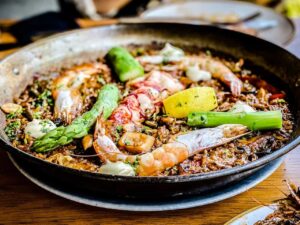 Paella valenciana
Paella valenciana
Originally, paella made in Valencia was a lunchtime meal for farmers and farm laborers. Workers would gather what was available to them around the rice fields. This often included tomatoes, onions, and snails. Rabbit or duck was a common addition, or chicken less often.
On special occasions, 18th century Valencians used calderos to cook the rice in the open air of their orchards near lake Albufera. Water vole meat was one of the main ingredients of early paellas, along with eel and butter beans. Novelist Vicente Blasco Ibáñez described the Valencia custom of eating water voles in Cañas y Barro (1902), a realistic novel about life among the fishermen and peasants near lake Albufera.
Living standards rose with the sociological changes of the late 19th century in Spain, giving rise to gatherings and outings in the countryside. This led to a change in paella’s ingredients, as well, using instead rabbit, chicken, duck and sometimes snails. This dish became so popular that in 1840, a local Spanish newspaper first used the word paella to refer to the recipe rather than the pan.
The most widely used, complete ingredient list of this era was: short-grain white rice, chicken, rabbit, snails (optional), duck (optional), butter beans, great northern beans, runner beans, artichoke (a substitute for runner beans in the winter), tomatoes, fresh rosemary, sweet paprika, saffron, garlic (optional), salt, olive oil, and water. Poorer Valencians, however, sometimes used only snails for meat. Many Valencians insist that no more than these ingredients should go into making modern paella valenciana, and, in particular, that fish and shellfish are “absolutely out of the question”. Another important rule, according to Valencians, is that fresh rosemary should not be added to paella valenciana made with rosemary-eating snails.
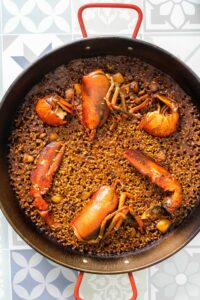 Seafood and mixed paella
Seafood and mixed paella
On the Mediterranean coast, Valencian fishermen used seafood instead of meat and beans to make paella. In this recipe, the seafood is served in the shell. Later, Spaniards living outside of Valencia combined seafood with meat from land animals and mixed paella was born. This paella is sometimes called preparación barroca (baroque preparation) due to the variety of ingredients and its final presentation.
During the 20th century, paella’s popularity spread past Spain’s borders. As other cultures set out to make paella, the dish invariably acquired regional influences. Consequently, paella recipes went from being relatively simple to including a wide variety of seafood, meat, sausage (including chorizo), vegetables and many different seasonings. However, the most globally popular recipe is seafood paella.
Throughout non-Valencia Spain, mixed paella is relatively easy to find. Some restaurants both in Spain and abroad that serve this mixed version refer to it as Paella valenciana. However, Valencians insist that only the original two Valencia recipes are authentic, and generally view all others as inferior, not genuine or even grotesque.
Basic cooking methods
According to tradition in Valencia, paella is cooked over an open fire, fueled by orange and pine branches along with pine cones. This produces an aromatic smoke which infuses the paella. Also, dining guests traditionally eat directly out of the pan instead of serving in plates.
Some recipes call for paella to be covered and left to settle for five to ten minutes after cooking.
After cooking paella, there may be a layer of roasted rice at the bottom of the pan, called socarrat in Valencià. The layer develops on its own if the paella is cooked over a burner or open fire. This is traditionally considered positive (as long as it is not scorched) and Valencia natives enjoy eating it.
Wikipedia contributors, “Paella,” Wikipedia, The Free Encyclopedia, https://en.wikipedia.org/w/index.php?title=Paella&oldid=1108819695 (accessed September 9, 2022).

